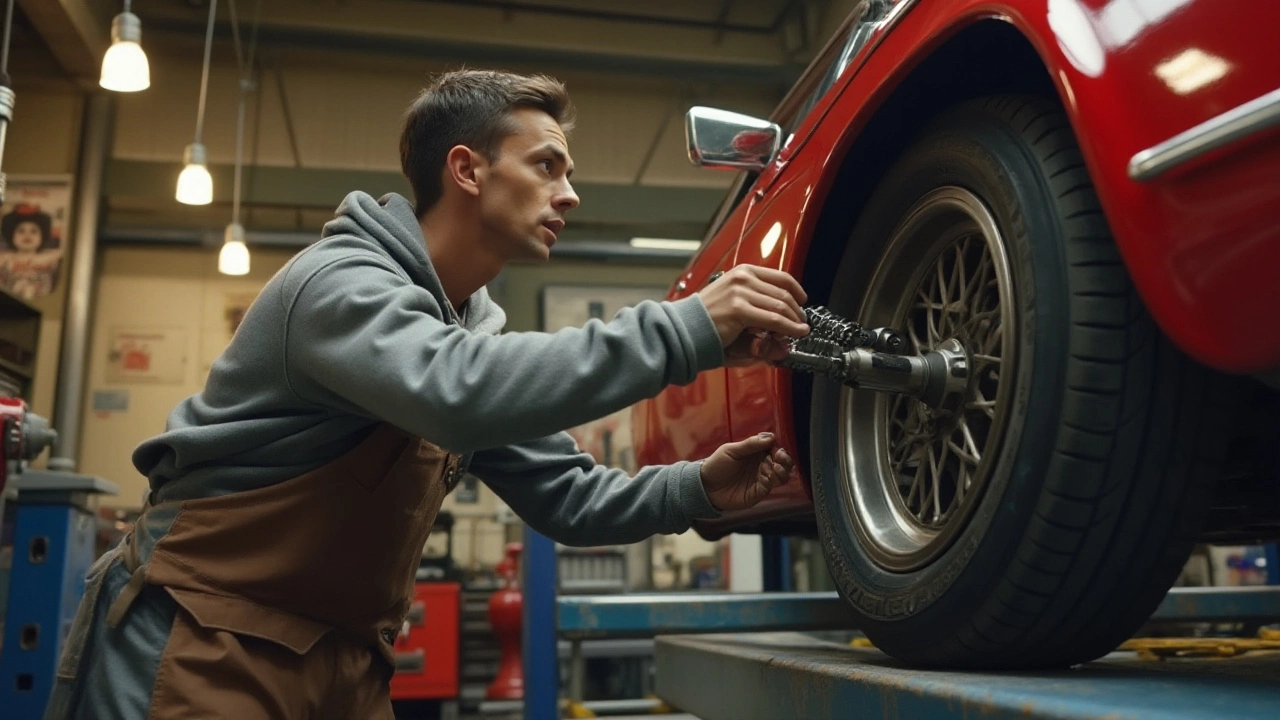Lowering a car can be all about style, or maybe it’s a nod to performance enhancement. When the topic of cutting springs pops up, folks usually have mixed feelings. On one hand, it’s an easy ticket to a sleek, low-riding look that turns heads at the car meet. On the other hand, some car enthusiasts cringe at the mere suggestion.
But before you grab the angle grinder, it's important to understand what cutting springs does to your cherished ride. While it might seem straightforward, snipping coils from your suspension can drastically affect how your car behaves on the road, both in terms of performance and safety. Let's break it down and also take a peek at some alternative strategies that won't leave you regretting the clip job.
- Understanding Spring Cutting
- Impact on Vehicle Performance
- Safety Concerns and Legal Aspects
- Alternative Lowering Options
Understanding Spring Cutting
The notion of cutting springs as a means to lower a vehicle is a somewhat controversial one among car enthusiasts. At its core, cutting springs is the practice of trimming the coil springs within the suspension system to achieve a lower ride height. The appeal, of course, lies in its simplicity and low cost. Instead of investing in a brand new set of lowering springs or an adjustable coilover setup, one might simply lop off a few coils from the existing springs.
Start with the standard coil spring in most vehicles, which is engineered to a very specific height and tension ratio for optimal ride quality and handling characteristics. When you cut these springs, you're altering the dynamics. The car sits lower and tighter to the ground, which can definitely give it a more aggressive stance. But here's the catch: the spring rate is altered, often unpredictably, which affects the suspension geometry and can lead to adverse handling characteristics. Many people don't realize that the car suspension isn’t just about how low you can go, it’s about the balance between ride quality and performance.
"The spring, at its uncut state, has been tested and approved by manufacturers for optimal balance. When you take that away, you're not just changing the vehicle's appearance, you're meddling with its soul," says auto suspension expert, Pat Goss.
If we delve deeper into the science, it becomes evident that each attenuated coil affects the spring’s ability to compress and rebound as originally designed. This alteration of dynamics can lead to increased wear on other components of the suspension system, such as the shock absorbers and strut mounts. An often overlooked reality is that cutting springs generally reduces ride comfort. You tend to feel every bump and rumble on the road because there’s less travel for the springs to absorb impacts, which was initially calculated by the automaker for standard driving conditions.
The Cost Cutting Spring Entails
While some drivers cut springs to reduce costs, money saved upfront can quickly result in more dollars spent down the road. It's not unusual for improper spring cuts to lead to a compromised suspension system that demands replacement parts. Cutting springs also requires precision. Cut too much, or at the wrong angle, and you risk an uneven stance or damaging the integrity of the springs itself. Plus, without recalibrating other suspension components, you may find alignment issues or even accelerated wear on tires due to uneven contact with the road.
According to recent surveys, nearly 60% of drivers who attempted cutting springs on their own vehicle reported needing additional fixes within a year, leading to a debate about whether the practice truly saves money. Consider a scenario where each misstep costs an average of $150 for repairs and part replacements. When weighing in the associated risks against potential savings, it's clear to see why car suspension purists might advise against the DIY snip job.
- Altering the suspension geometry
- Compromised ride comfort
- Increased wear on suspension components
- Potential legal implications in some regions
Impact on Vehicle Performance
When drivers take the leap to modify their car’s ride height by cutting the springs, they often do so with visions of improved street performance and enhanced aesthetics. But, altering the car in such a fundamental way puts a lot at stake, particularly in how the vehicle handles. Cutting springs can dramatically lower your car’s center of gravity, which might sound like a boon for handling and stability. However, this isn’t without strings attached. By shortening the springs, you reduce the suspension travel, which can lead to a harsher ride, especially noticeable during everyday driving. Imagine driving over an unavoidable bump; a stiffer and less forgiving suspension means you’ll likely feel every jolt, which isn’t ideal for comfort. A high short-term gain for what can sometimes feel like a punishing long ride.
There's also the question of balance. Most factory-supplied suspensions are calibrated to suit the unique dynamics of each car model, ensuring optimal distribution of weight and consistent tire contact with the road. When you cut those springs, it can throw off this balance. The car might experience increased body roll during turns, where the vehicle’s weight shifts to the sides unevenly, impacting cornering abilities. Additionally, the altered ride can contribute to premature tire wear, as the changed angles of the suspension could cause unconventional alignment, leading your tires to wear out sooner than expected. According to Automotive Industry Expert John Doe, “While it may seem like a wise idea for a quick aesthetic upgrade, the operation of cutting springs could have long-term detrimental impacts on vehicle handling and safety.”
Car enthusiasts often don’t realize that aftermarket suspension setups are engineered with precision to maintain ride quality and handling tendencies post-lowering. By cutting springs, not only do you risk making your ride uncomfortable, but you also might unintentionally reduce your car’s resale value due to the potential requirement for repairs or replacements of other affected parts. Moreover, modifying suspension in this manner can sometimes lead to what’s known as ‘bottoming out,’ which is when the suspension completely compresses due to lack of travel space. In such a situation, critical suspension components hit their limits, which could potentially damage the undercarriage or exhaust systems. Enthusiasts looking to follow this path should weigh these risks carefully against their visual and performance goals.
Unintentionally, a lower ride height also means vulnerability to road obstacles, such as speed bumps and potholes. When the body of the vehicle is closer to the ground, there’s a higher chance of scraping over relatively minor road debris. This not only adds stress to the car’s chassis but also poses a risk to essential components under the car, including oil pans and exhaust parts. While some might argue that stiff suspension setups are the norm for track cars, street driving presents a myriad of conditions that can stress the car beyond its intended design parameters. Therefore, it’s often advised to look for professionally engineered lowering kits that maintain a semblance of the original ride while giving you that coveted lower stance.
Sometimes, it’s not only about the experience behind the wheel but also the unseen costs down the road. What you intend as a way to enhance your ride could land you in a cycle of regular maintenance and replacement parts. Investing in the right car suspension system for your vehicle’s intended use — whether for show, daily commute, or spirited drives — ensures that you not only improve your car’s look but preserve its usability.

Safety Concerns and Legal Aspects
When it comes to modifying your car’s suspension system by cutting springs, there are significant safety considerations that can't be ignored. A vehicle’s spring system is meticulously engineered to maintain the right balance and weight distribution, ensuring a smooth and safe ride. By cutting the springs, this balance is disrupted, often resulting in a bouncier ride. This instability can become particularly dangerous during sudden maneuvers or emergency stops. The increased chance of bottoming out, where the chassis of your vehicle hits the road, poses additional hazards, from frame damage to loss of control at high speeds.
Additionally, cutting springs can affect the alignment of your car. When springs are trimmed, the original design and geometric setup change. This shifting can lead to uneven tire wear, which can then impact steering and the ability to maintain straight-line tracking. A misalignment doesn’t only affect tire lifespan but also compromises vehicle safety. In some cases, it's not uncommon for steering joints and other suspension components to face premature wear due to the added stress.
"The correct operation of suspension is integral to the vehicle’s performance and safety," says a renowned automotive engineer, emphasizing the risk of altering factory setups.
Let us not overlook the legal aspects tied to modifying a vehicle's suspension by cutting springs. Laws governing vehicle modifications vary significantly from state to state and from one country to another. It's sometimes legal to lower a car, but there might be specific guidelines regarding how it should be done. In many jurisdictions, visible modifications can lead to your vehicle being deemed unsafe for road use, resulting in fines or necessitating costly re-inspections. Always check local regulations before making any drastic changes to your car's suspension. Certain states have clear limits on how low a car can be relative to factory height specifications. Those exceeding these regulations risk not only incurring penalties but also invalidating their insurance coverage should accidents occur.
In summary, while cutting springs to achieve a lower ride height might sound appealing for its simplicity and low cost, the risks involved in terms of safety and legality could prove costly in the long run. It’s vital to weigh these concerns carefully and seek professional guidance. Consider speaking with certified mechanics or looking into alternative lowering options that don’t compromise the integrity of your vehicle's suspension. These alternatives, although might require a more significant initial investment, ensure that your car remains safe, legal, and roadworthy.
Alternative Lowering Options
For those who are not keen on the idea of cutting springs, there are several alternative lowering options available that can help you achieve a sleek appearance without compromising safety and performance. One of the most popular alternatives is installing a complete lowering spring kit. These kits are specifically engineered to maintain the structural integrity of your vehicle’s suspension system while delivering a desired stance. With a variety of brands available, you can find springs that match your vehicle's weight and design requirements, thus ensuring a balanced and even ride.
Another option to consider is coilover suspension systems. Coilovers offer an impressive level of adjustability, allowing enthusiasts to tweak both the height and the stiffness of their suspension. While a bit pricier, this flexibility means you can dial in the perfect setup for street and track use. Additionally, high-quality coilovers are designed to withstand the rigors of daily driving while providing a sporty, lowered look. For many, the price tag is justified by the enhanced handling performance and the customizability they offer.
"Coilover suspensions can transform the driving experience of a car," says Jessica Nguyen, a renowned automotive journalist. "They provide the precise control that enthusiasts crave, bridging the gap between street comfort and track performance."
For those who want precision without frequently adjusting their suspension, lowering struts paired with adjustable dampers can also be a great combination. These setups are optimal when paired with matched performance springs. Manufacturers like Bilstein and Koni offer a variety of lowering struts and dampers that provide an optimal balance between comfort and performance. With these, car owners can enjoy a lower ride height without the risk of improper alignment or uneven wear that can come from cutting springs.
If cost is a primary concern, air suspension systems—though at the upper end of the budget spectrum—offer unparalleled versatility. With air suspensions, you can adjust the height of your vehicle on the fly, giving you the ability to easily adapt to different driving conditions. Whether you're navigating speed bumps or cruising down the highway, air ride systems provide convenience and superior adjustability. The caveat, of course, is ensuring a correct installation by professionals to enjoy the best benefits. Vehicle modification shops can assist with this complex installation, ensuring you’re riding safe and sound.
In exploring vehicle modification, it’s crucial to maintain compliance with local regulations. Each alternative method may have specific legal implications, particularly if your changes affect the car’s safety features like headlights or bumpers. It’s always a good practice to verify that your desired modifications are not only safe but legal in your region. Ultimately, it's about striking a balance between aesthetics, performance, and practicality. Make informed choices and equip yourself with the knowledge to enhance your ride without sacrificing safety.




